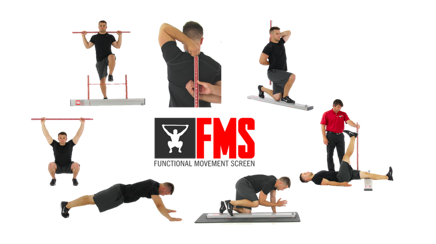What Is Normal On the FMS?
Posted by FMS
“The FMS model is not a time-based, it is a behavior-based model.” Gray Cook
Out of the many questions asked by those using the FMS system, “How long do I perform drill X” or “How long till pattern X changes?” have got to be the most common. Whether posed on a forum or in an email, the questions come up frequently.
So how long do you perform drill X or how long till pattern X changes?
Let’s dive in here and see if we can clarify the behavior-based vs. time-based perspectives.
As exercise professionals, we are used to thinking in time frames. Microcycles, mesocycles, and macrocycles are familiar time-based frameworks for periodization and planning exercise progression. Another common timeframe example in programming is when we attribute the first 4-6 weeks of improvements in a strength training program as neurological adaptations before structural adaptations become primary. And let’s not forget to switch exercises every 4-6 weeks to prevent adaptation time frame. So as exercise professionals, we are conditioned (pun intended) to think in time frames.
 The issue with this -- once we are addressing movement patterns -- is that movement patterns are behavior-based. They are pre-programmed just like any behavior. And behavior changes much faster under the right conditions. I know what you are thinking. Behavior changes quickly? Give me a break. But read me out (you are listening to the voice in your head not me…so you can’t hear me out… but I digress).
The issue with this -- once we are addressing movement patterns -- is that movement patterns are behavior-based. They are pre-programmed just like any behavior. And behavior changes much faster under the right conditions. I know what you are thinking. Behavior changes quickly? Give me a break. But read me out (you are listening to the voice in your head not me…so you can’t hear me out… but I digress).
To change that behavior, did you identify the root issue, definitively find the strategy that would change it and apply that strategy consistently? No? You will likely blame lack of “will power” as the point of failure, not the ability to change a habit or behavior. But it is typically a lack of identifying the root cause and definitively finding a strategy that creates change and consistently applying that strategy that fails to change behavior. Applying that process of identifying the root cause etc. is the FMS strategy for successfully changing movement patterns in a nut shell.
Step 1: Identify the root issue
This simply means running a great FMS screen and correctly identifying the movement pattern that needs to be addressed.
Step 2: Definitively finding a strategy that creates change
This means “filtering” the corrective exercises and strategies to find the ones that create change in the pattern right now. It’s not focused on a change of score, but aims at an improvement in that pattern as a result of the drill you just applied to the individual. And, move as far down the “corrective path” as you can during any given day.

If you create a change in Mobility, then move on to Static MC. If the Static MC improves, and the Mobility holds, or even improves more, then move on to Dynamic MC and be sure that the pattern continues to improve. You will know you have gone too far when progress stops or regresses. Simply step back to the sequence that created positive change and that will be the strategy for that individual. So it is not a time-based strategy of 1 or 2 weeks of mobility, then 1 or 2 weeks of stability etc… It is moving down the corrective path as far as you can while having positive short-term responses in every session.
Step 3: Consistently apply the strategy
The strategy that you found to create positive change needs to be consistently applied in order to create adaptation. “Positive short term response leads to long term adaptation.”
This is the key to quickly changing movement and why the FMS strategy is behavior-based, not time-based.
Think of quitting smoking. One cigarette after a week of not smoking can unravel all those days of not smoking and knock you back to square one. If you always have a cigarette after eating, and you sit there after your meal, then your brain will create the intense desire for a cigarette. But, if you change that setting so you get a positive short-term response (for example, you go for a walk and do not have a cigarette), and you keep encouraging that response, then you get long-term adaptation.
So if the attempt is based around a successful strategy that is consistently applied, then one cigarette has less of a chance of derailing all progress because you can simply immediately reboot the successful strategy and apply it again and again. An efficiently performed strategy of 2-4 drills that creates positive response in a movement pattern -- that progress accordingly and achieve positive short-term response -- can change movement patterns quickly and achieve long-term adaptation.
This means encouraging the positive short-term response as often as we can without failure or fatigue becoming an issue. It could be once a day or twice a day or more; it all depends on the individual and their response. This can change movement behavior in a very short time frame. It could only be a matter of sessions, or take a few weeks, but continual progression and application of a successful strategy can create quick adaptation.
Let’s take a look at a response vs. adaptation case study example:
Grandma Betty is seeing a trainer or therapist for balance issues. She walks on the balance beam (4” wide x 1” high) for 2 min in “warm-up” and we are looking at the number of step-offs in those 2 minutes. After that, we apply a mobility drill paired with a stability drill, and notice 50% improvement in competency (50% fewer step offs in the two min) on the balance beam.
In this case, we achieved a response, not an adaptation. We will only know if the response is creating an adaptation by checking the balance beam exercise again in the next session (without first doing the drills that led to the improvement). She could be 25% better next session, meaning some carryover happened, but we need to continue to encourage the positive response and Grandma Betty may need to do her “homework” more often. “Homework” is not the balance beam, but the drill is the key strategy for her.
How do you know when you can move on from a movement pattern?
When the individual comes into a session with no prep or correctives and the pattern is improved, as defined by an improvement in score. Now you can rescreen the other patterns to see if there is anything else to address. If yes, go through the three steps again and find that successful strategy and consistently apply it. If no, go on to great programming that achieves the goals and encourages great movement quality. But keep an eye on the baseline!
Breaking the time frame mindset takes a little time (funny!), but is worth the effort. Efficiently and effectively changing movement allows us to get to the fun stuff of training and developing the qualities needed to accomplish our client’s goals.
Brett Jones, Chief SFG, is a Certified Athletic Trainer and Strength and Conditioning Specialist based in Pittsburgh, PA. Mr. Jones holds a Bachelor of Science in Sports Medicine from High Point University, a Master of Science in Rehabilitative Sciences from Clarion University of Pennsylvania, and is a Certified Strength & Conditioning Specialist (CSCS) from the National Strength and Conditioning Association (NSCA).
With over twenty years of experience, Brett has been sought out to consult with professional teams and athletes, as well as present throughout the United States and internationally.
As an athletic trainer who has transitioned into the fitness industry, Brett has taught kettlebell techniques and principles since 2003. He has taught for Functional Movement Systems (FMS) since 2006, and has created multiple DVDs and manuals with world-renowned physical therapist Gray Cook, including the widely-praised “Secrets of…” series.
Brett continues to evolve his approach to training and teaching, and is passionate about improving the quality of education for the fitness industry. He is available for consultations and distance coaching by e-mailing him at appliedstrength@gmail.com. Follow him on Twitter at @BrettEJones
Posted by FMS
Posted by Gray Cook
Brett,